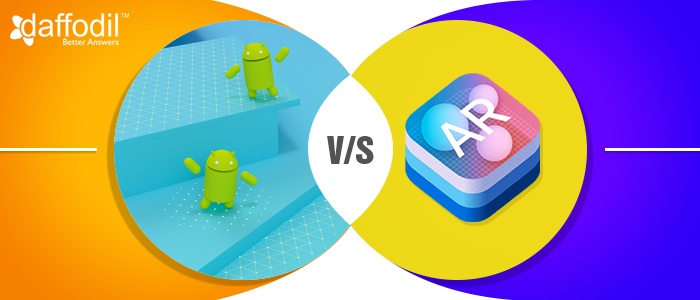
Pokemon Go, Google Translate, Snapchat, SkyMap. These names have certainly turned the tables for AR technology, bringing it into the mainstream. If sources are to be believed, the AR/VR market will have a worth of 80 billion USD by 2025, with 45 billion USD coming from hardware and 35 billion USD from software.
Giving consideration to massive user acceptance to AR, Apple unveiled ARKit in its World Wide Developer’s Conference 2017. It’s a framework that enable developers to build AR experiences for iPhone and iPad, using the built-in camera, processors, and motion sensors of the device.
While Apple is just an entrant into the world of virtual reality with the ARKit, its competitor, Google has been on the field for years. It is evident from some of the Google’s past (and very successful) VR and AR projects like Cardboard, Daydream, and Tango.
Holding on to its position in developing virtual world, Google hurled back to Apple’s ARKit with its ARCore, which is an Augmented Reality SDK for developers. Quite similar to ARKit, ARCore blends the digital and physical world on Android devices, including smartphones and tablets.
Now that both the tech-giants have made an official announcement about their AR platforms, it's the time to look into the differences and similarities between the two. Let’s get started.
What is Google’s ARCore?
ARCore is an SDK to build Augmented Reality apps for Android devices running 7.0 Nougat or above. Quite similar to Google’s project Tango, ARCore will enable the devices to discover the physical objects in the environment and display the AR content. For this, the application will make use of smartphone sensors to detect motion, light, or patterns. The objects will thus be available on the basis of environment. Currently, a preview version of ARCore has been made available by Google and developers can start experimenting with it now on Pixel and Samsung S8 devices.
What is Apple’s ARKit?
With ARKit, Apple enable the developers to build Augmented Reality apps for iOS 11 and above. ARKit runs on Apple A9, A10, and A11 processors that are known for quick understanding of a scene, enabling a detailed and compelling virtual world on the real content. This AR framework for iOS apps is available for development, along with thorough documentation.
ARCore vs ARKit: Hardware and Software
ARCore was announced months after ARKit. However, the possibilities that both these platforms brings in are quite similar.
- The ARKit works in Metal, SceneKit, and external tools like Unity and Unreal Engine for optimization. Similarly, ARCore works with Java/OpenGL, Unity, and Unreal. With this, it enables motion tracking, light estimation, and environment understanding.
- Both the environments do not require special hardware configuration to build Augmented Reality apps. They can render the best possible output on the existing smartphone hardware like camera or sensors.
- On the software end, the ARKit is only compatible with iOS 11 and above. On the other end, ARCore is available on all the devices running Android Nougat and above. As, as long as you have the device that’s running on the latest OS, downloading AR apps from the App Store and Play Store is possible.
ARCore vs ARKit: Availability and Device Compatibility
The Augmented Reality SDK for iOS, i.e. ARKit is available to all developers with Apple Developer account. It was working on devices with iOS 11 beta since its launch and will be working all iOS 11 (or above) compatible devices (which is released on 12 September with iPhone 8).
As of now, Google has released the preview of the Augmented Reality SDK, which can be tested on Google’s Pixel and Samsung’s S8 devices running on Android Nougat or Oreo. In an official blog, Google confirms that it is targeting 100 million devices at the end of this preview. For this, they are working with manufacturers like Samsung, Huawei, ASUS, and others.
ARCore vs ARKit: Defining the Future of AR in Mobile Apps
User experience is the catchword in app marketplace. To take mobile app development to next level, new trends and technologies are being followed to render solutions that are out of the ordinary. And amongst them is Augmented Reality app development that’s nailing the out-of-the-box-development ideas. To make AR app development a seamless experience for developers, these Augmented Reality SDKs will prove to be a sure assistance.



